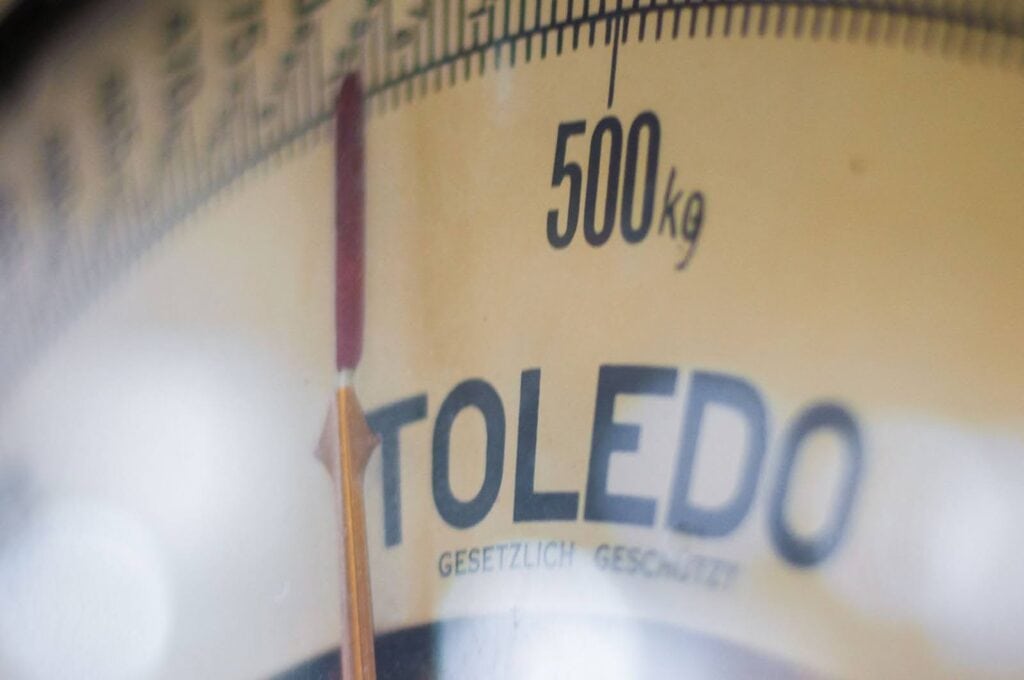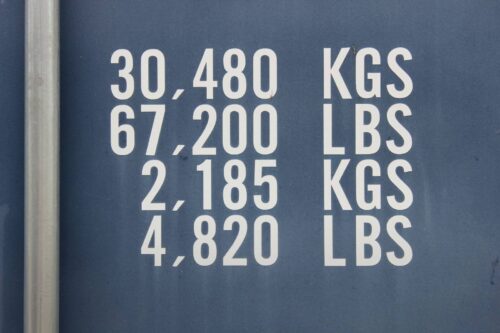Net Weight vs. Tare Weight vs. Gross Weight: A Comprehensive Guide

Net weight, tare weight, and gross weight are key terms in the shipping industry. They affect the cost and safety of global trade and transport. Anyone involved in shipping should know the difference between net weight vs gross weight vs tare weight.
The Importance of Shipping Weights
Shipping weights are indispensable in logistics. They influence everything from shipping costs to safety standards on transport vehicles.
Incorrectly declared weights can have serious repercussions, including damaged cargo protection equipment, freight company penalties, and transportation concerns.
Net Weight Defined
Net weight refers to the weight of the goods alone, devoid of any packaging or ancillary components. In essence, it’s the pure weight of the product. You’ll typically find the net weight listed on product labels, especially in the food industry, where it indicates the product’s weight exclusive of its packaging.
Tare Weight Defined
Tare weight is another crucial metric in the shipping industry. It signifies the weight of an empty container.
If you were to weigh an empty shipping container without any cargo load, the number you’d get would be its tare weight. It’s crucial in calculating how much weight shipping companies can safely carry.
Gross Weight Defined
Gross weight represents the combined shipment weight and all its packaging materials, including the container’s weight. In other words, it is the total weight of a product and its packaging. This gross weight is usually referenced in documents such as weight declaration documents, shipping manifests, bills of lading, and air transport documentation.
The gross weight calculation helps with shipping costs and the chargeable weight.
Industry Standards for Cargo Weight Calculations

Within the shipping industry, the accurate weight calculations for cargo are governed by strict standards. International bodies, freight companies, and shipping industry regulators uphold these standards.
Violation of shipping industry weight regulations can result in hefty penalties, shipment delays, and potential damage to goods. For shipping goods for instance, the formula to calculate gross weight is:
Gross Weight = Net Weight + Tare Weight.
Take a scenario where you have a cargo with a net weight of 20,000 kilograms and a container (tare weight) weighing 2,300 kilograms. The total gross weight of the container will be 22,300 kilograms.
International Shipping Standards
Internationally, weight standards are overseen by bodies like the International Maritime Organization (IMO) and the World Shipping Council.
Gross Combination Weight
The Gross Combination Weight (GCW) is the total vehicle’s weight, including its cargo, passengers, and trailer. In freight transportation, this metric is pivotal to ensuring that trucks and their cargo do not exceed the maximum allowable weight for safe operation.
The formula for GCW is:
Gross Combination Weight = Weight of Powered Vehicle + Weight of Trailer + Cargo Weight.
For example, if a truck weighs 15,000 kilograms, the trailer 5,000 kilograms, and the maximum cargo weight is 10,000 kilograms, the GCW will be 30,000 kilograms.
Gross Combination Mass
Gross Combination Mass (GCM), denotes the maximum allowable weight of a vehicle combination when loaded to its fullest. It considers the vehicle, its passengers, cargo, and any towed units. The formula for GCM might vary depending on specific vehicle types, but typically,
Gross Combination Mass = Gross Vehicle Mass (GVM) + Maximum Permissible Trailer Mass.
For instance, a truck with a GVM of 20,000 kilograms, when towing a trailer with a maximum permissible mass of 10,000 kilograms, should not exceed a GCM of 30,000 kilograms.
Gross Verified Mass
The Gross Verified Mass (GVM) or Verified Gross Mass (VGM) represents the combined weight of a shipping container’s tare weight and all its cargo.
As to the International Maritime Organization’s SOLAS (Safety of Life at Sea) regulations, shippers must verify and provide the VGM of packed containers before loading onto ships. This measure was instituted to improve vessel and cargo safety.
The formula for GVM or VGM is:
Gross Verified Mass = Container’s Tare Weight + Weight of Cargo.
Gross Vehicle Mass
Gross Vehicle Mass (GVM) is the maximum weight a vehicle can legally weigh when fully loaded. It encompasses the vehicle’s unladen weight plus the weight of its cargo.
Gross Vehicle Mass = Vehicle’s Unladen Weight + Maximum Allowable Payload.
Gross Vehicle Weight
Gross Vehicle Weight (GVW) refers to the actual weight of a vehicle, including its base weight and the weight of any cargo. Unlike GVM, which is a limit, GVW is a current measurement.
Gross Vehicle Weight = Vehicle’s Unladen Weight + Current Payload.
Gross Trailer Weight
Gross Trailer Weight (GTW) is the full weight of a trailer. This measurement is crucial as it determines the type of hitch required on a transport vehicle for towing and ensures the trailer matches an appropriate towing vehicle.
Gross Trailer Weight = Trailer’s Unladen Weight + Weight of the Cargo.
Net vs. Gross vs. Tare
Net weight, gross weight, and tare weight are three different ways of measuring the weight of a product or a shipment. They are essential to distinguish because they have different implications for the cost, safety, and efficiency of transportation and trade.
Payload Weight
Payload weight is the weight of the cargo or passengers that a vehicle can carry. It is calculated by subtracting the vehicle’s unladen weight (or kerb weight) from its gross vehicle mass (GVM). Payload weight is important for determining the vehicle’s performance, fuel efficiency, and safety.
For example, if a truck has a GVM of 10,000 kg and an unladen weight of 6,000 kg, its payload weight is 4,000 kg. This means that it can carry up to 4,000 kg of cargo or passengers without exceeding its GVM limit.
Kerb or Curb Weight
Kerb or curb weight is the weight of a vehicle when it is empty of any cargo or passengers but with a full tank of fuel and all other fluids. It is also known as unladen weight. Kerb or curb weight is used to measure the vehicle’s base weight and compare its performance and fuel efficiency with other vehicles.
For example, if a car has a kerb or curb weight of 1,500 kg and a payload capacity of 500 kg, its gross vehicle weight (GVW) is 2,000 kg when it is fully loaded. The kerb or curb weight indicates how much the car weighs without any load.
Examples of Net, Gross, and Tare Weight Applications
Understanding the distinctions between net weight vs tare weight vs gross weight is paramount in product packaging and the shipping industry. Let’s delve into some practical applications to elucidate these terms:
- Grocery Stores: A tin of beans may have a net weight of 400 grams, representing the weight of the beans alone. If the tin weighs 50 grams, the gross weight (beans + tin) is 450 grams.
- Online Retail: When shipping a ceramic vase, an e-commerce store would consider the net weight as the weight of the vase itself. The combined weight (vase + box + bubble wrap) represents the gross weight if it’s packed in a box with bubble wrap.
- Logistics Scenarios: Freight companies need to know the weight of a container (tare weight) and the weight of the goods inside (net weight) to determine the total gross weight.
Common Misconceptions About Weight Terms
Misunderstandings regarding the weight management terminology can confuse, especially in the packaging and shipping sectors. Here’s a breakdown of some prevalent misconceptions:
- “Tare Weight Includes the Product”: One common fallacy is assuming tare weight includes the product. Tare weight only pertains to the packaging or container’s weight.
- “Gross Weight is Just the Product’s Weight”: Many mistakenly believe gross weight denotes only the product’s weight. However, gross weight combines both the product’s net weight and the tare weight of its packaging.
- “Shipping Labels Display Net Weight”: Shipping labels often indicate the gross weight, not the net weight. This total includes the weight of the item and its packaging, essential for calculating shipping costs.
FAQs
Dive into these frequently asked questions to gain clarity on cargo weight definitions.
What is tare vs. gross vs. net?
Tare is the weight of the empty container or packaging. Gross weight includes product weight and packaging. Net is only the product’s weight.
What is the formula for net weight?
Net weight = Gross weight – Tare weight.
What does tare weight mean?
Tare weight refers to an empty container or packaging without its contents.
Summary of Cargo Weight Definitions
Distinguishing between net weight vs gross weight vs tare weight is critical in packaging and determining shipping costs. These terms dictate safety, cost, and logistical considerations, ensuring efficient and cost-effective transportation of goods.
